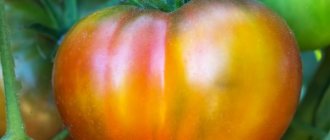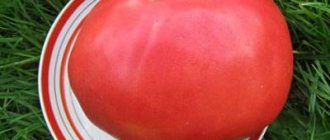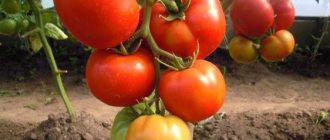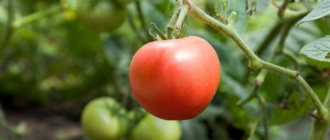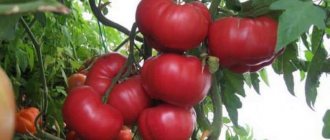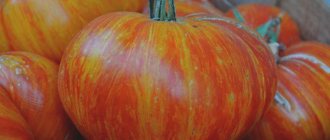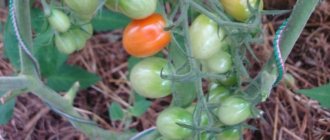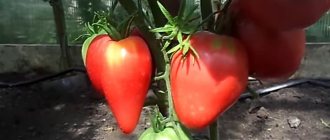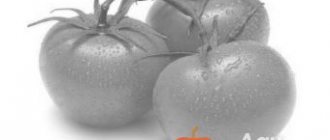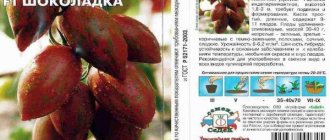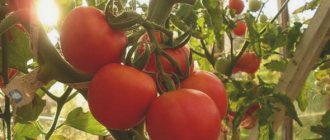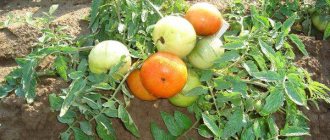Tomato “King of Kings”: variety description
| Variety name | King of Kings |
| general description | Indeterminate, mid-late variety of large-fruited tomatoes |
| Originator | Institute of General Genetics named after. Vavilova RAS |
| Ripening period | 110-120 days |
| Form | The surface is slightly ribbed, smooth, the shape is round, slightly flattened. The pulp is dense, fleshy, not too juicy |
| Color | at maturity bright red color |
| Average weight of tomatoes | from 200 grams to 1.5 kg |
| Application | Table appointment. Perfect for making salads, can be processed into juices, pastes, and purees. Not used for canning or pickling. |
| Productivity of the variety | 7-8 kg per square meter |
| Features of cultivation | Sowing 65-70 days before planting, no more than 3 plants per 1 sq.m., forming into 1-2 stems with mandatory tying to a support. |
| Disease resistance | Resistant to late blight, susceptible to whitefly attack |
This is a fairly new variety.
There is very little information about him. The originator is the Institute of General Genetics named after. Vavilov RAS. Included in the State Register of the Russian Federation for personal plots and farms only in the mid-2000s. Suitable for growing indoors. Basic . The King of Kings is a complex F1 hybrid. This means that there is no point in collecting seeds from ripened fruits yourself, since they will not be able to grow the same plant. To do this, you will have to purchase an original package of seeds every year. The bush is not standard, about 1.5-2 m high, highly branched, medium leafy. It requires careful shaping and pinching. The first brush begins to be laid above the 9th leaf, and the rest - every 3 leaves. Form a plant on 1 or 2 stems. Be sure to tie it to a long, strong support.
This is a late or mid-late ripening hybrid. From planting seeds for seedlings to harvesting, it takes about 110-120 days. Greenhouse cultivation is suitable for central Russia. To the south - cultivation is possible without shelter, in open ground.
It has good resistance to late blight. Read about varieties with the same quality here. You can also learn from our article how to grow a good crop of tomatoes in open ground.
With proper care, timely fertilizing with the right fertilizers, and watering, the yield of the “King of Kings” hybrid is extremely high - up to 5 kg per bush. According to reviews from experienced gardeners, when planting such tomatoes in film greenhouses, the yield is slightly higher than when grown in large glass or polycarbonate greenhouses.
In the table below you can see what the yield of other tomato varieties is:
| Variety name | Productivity |
| King of Kings | 5 kg per bush |
| Grandma's gift | up to 6 kg per bush |
| Brown sugar | 6-7 kg per square meter |
| Premier | 6-9 kg per square meter |
| Polbig | 3.8-4 kg per bush |
| Black bunch | 6 kg per bush |
| Kostroma | 4.5-5 kg per bush |
| Red bunch | 10 kg per bush |
| Lazy | 15 kg per square meter |
| Doll | 8-9 kg per square meter |
Features of cultivation, planting and care
We recommend sowing the seeds of this tomato variety for seedlings 60-65 days before the intended planting in the ground. Picking seedlings - at the stage of 2 true leaves. When transplanting seedlings to a permanent place, 1 sq. m it is recommended to place up to 6 plants.
Further care for tomatoes consists of timely watering, weed removal, fertilizing with complex mineral fertilizer, pinching and preventive measures to protect the crop from diseases and pests.
Formation and care of determinate tomatoes, video
If you grew King of the Early tomatoes, please write how you liked it. What was the yield and taste of the fruit? Does the variety really catch tomato diseases easily? Will you grow it again? Briefly describe the advantages and disadvantages of this tomato. If possible, attach a photo of the entire bush or individual fruits you grew to your comment. Thank you!
Reviews of the Early King tomato and additions to the description will help many gardeners evaluate this one and decide whether it is worth planting or not.
Features of culture
The tomato belongs to the category of mid-season variety; the period from germination to ripening is 110–118 days. Biological characteristics - a tomato bush of an indeterminate type (unlimited growth), tall, strong, reaches a height of 1.5–2 m. The brush develops above the 7–8 leaves, subsequently ovaries and fruits form on it. The following brushes are evenly distributed on the bush.
In the garden, the height of the bush is less, 1–1.2 m. The leaves are large, densely green, the tomatoes are initially light with dark streaks. Ripe fruits are round, flattened, orange in color with red stripes.
How to grow seedlings
Sowing seeds for seedlings begins 2 months before planting in the ground. For planting, seed material can be prepared independently, since the tomato is varietal, which means it retains its parental properties in the next generation.
Seed preparation
The seeds are carefully inspected for visible damage, laid out one at a time on the table. They are then checked for emptiness in the saline solution. The solution is prepared from 1 spoon of salt dissolved in a glass of water. Those grains that float to the surface are not suitable for sowing.
Seed material must be disinfected, especially that which is collected independently. Disinfection will not only strengthen the immunity of sprouts, but will also identify non-viable plants at the initial stage. For disinfection, prepare a weak solution of potassium permanganate and place the seeds in it for 20 minutes. Afterwards they are thoroughly washed and dried.
Container and soil
The royal tomato requires fertile and nutritious soil. It is prepared from garden soil mixed with humus and peat. For lightness, add a little washed river sand. After thoroughly mixing all the components, the resulting mixture is poured with a hot solution of potassium permanganate to destroy pathogenic flora.
Disinfected soil has a beneficial effect on the growth and development of seedlings. Then the soil is laid out in planting containers, at the bottom of which small drainage holes are made. Also, sawdust or small pebbles are placed at the bottom of the containers as drainage.
You can plant either in a common wooden box or in individual containers, for example: plastic cups, peat pots, paper honeycombs. The most convenient way to propagate seedlings is in peat pots. When grown in these containers, replanting into beds is not required; seedlings are planted in holes along with peat pots. They dissolve in the soil, additionally feeding the young roots with useful substances.
Sowing
The seeds are sown to a depth of 1.5 cm with a distance of 2-3 cm from each other, sprinkled with soil on top, slightly moistened with warm, settled water using a spray bottle and covered with film or glass to create a greenhouse effect. Until the first shoots, the planting containers are kept in a warm and bright room at a temperature of at least 25 °C. The film is periodically removed to ventilate the soil.
Seedling care
After the emergence of seedlings, the containers are moved to a well-lit place, on the windowsill.
Daylight hours for seedlings are 15-16 hours. If there is a lack of natural light, add phytolamps. Additional lighting must be taken care of in advance so that the first shoots immediately receive the required amount of light.
Water as the top layer of soil dries, without flooding the sprouts, carefully along the edge of the nursery with warm, settled water using a shallow watering can. After watering, the soil is loosened superficially so as not to touch the young roots.
During the seedling period, liquid fertilizers are applied twice for young tomatoes. This feeding is necessary for the full formation of young plants.
After 2-3 true leaves appear, the seedlings are planted, planted in separate containers. If the seedlings are left in a common box, then the distance between the bushes is increased to 10-15 cm.
2 weeks before planting, the seedlings begin to harden. To do this, they are taken outside for 40 minutes - 1 hour. Gradually, the time spent outdoors is increased to 13 hours. Simultaneously with daytime hardening, the night temperature in the room is reduced to 13 °C.
Care
To get early and abundant fruiting, timely:
- watering;
- feeding;
- mulching;
- formation;
- fungicide treatment;
- tying up shoots.
Watering
The plant's root system can only consume nutrients from the soil in dissolved form. As soon as the soil under the bush dries out, growth stops and cell aging begins. To avoid such processes, timely and regular watering is necessary.
Water for irrigation should have a temperature higher than the environment by 2-3 degrees. The watering rate is such that the entire earthen ball is completely soaked.
The most effective irrigation system is drip irrigation.
If the tomato growing zone is southern and the summer heat dries out the soil, then it is necessary to mulch the soil around the tomato shoot.
Feeding
Early tomatoes need more thorough feeding. They do not have the opportunity to wait for the supply of nutrients, since the ovary forms earlier than in mid- and late-ripening ones.
In order to have time to “supply” both nitrogen and phosphorus-potassium fertilizers to the plant organism, fertilizing is combined.
- The first feeding is carried out 1.5-2 weeks after planting in open ground. For her, 1 tbsp is dissolved in a bucket of water. spoon of ammonium nitrate and 1 tbsp. spoon of superphosphate. For each plant, add 0.5 liters of solution with early, abundant watering;
- The second feeding is carried out 1.5 weeks after the first with a solution of organic fertilizers. For this purpose, you can take both cow dung and other farm animals. The solution is prepared in a ratio of 1:10. A very good solution can be prepared from bird droppings. However, in this case the proportion will be 1:20.
- The next feeding is done after 1.5 weeks. Add 1 tbsp to a bucket of water. a spoonful of potassium sulfate.
Experienced vegetable growers carry out constant feeding with each watering. To do this, they make a solution according to this recipe:
For a bucket of water:
- ammonium nitrate - 2 tbsp. spoons;
- potassium sulfate - 2 tbsp. spoons;
- superphosphate - 2 tbsp. spoons;
- manure - 1 kg.
All this is dissolved, and before watering, one liter of “master” concentrated solution is added to each bucket of irrigation water.
Some vegetable growers completely refuse to use mineral fertilizers. But there is a special attitude towards organics. Thanks to these substances, the fruits have the taste and smell characteristic of natural tomatoes.
Formation
“King of the early” tomato is low-growing, determinate.
However, a small bush cannot independently support heavy fruits of 200 g each without breaking off the shoots. Naturally he needs fixation. As soon as the seedlings are planted, the peg is driven in and fixation begins.
The variety does not require stepsons, but if a lot of stepsons are formed, this inhibits the growth and ripening of tomatoes. To avoid delay in planting inflorescences, it is better to remove all stepsons below the first inflorescence, and then form them depending on the degree of vegetative development.
Treatment
No matter how resistant the variety is, if weather conditions are not in favor of a heat-loving tomato, treatments are needed.
The first spraying is carried out at the moment the tomato ovary appears, and then, depending on the weather, every 14-20 days.
The best results are achieved by alternating fungicidal preparations. Since they all have different waiting times from the moment of processing to the moment of consumption of vegetables, it is necessary to carefully monitor this. The “King of Early” quickly arrives at the table, which is why drugs are needed with a short waiting period.
The seed market is overflowing with high-quality varieties and hybrids. After carefully considering the proposals, you can choose those that have proven themselves over the years. Whatever variety you choose, following agricultural techniques will allow you to get a decent harvest.
Agricultural technology for growing tomato seeds in open ground
The early king can be grown not only through seedlings, but also by sowing seeds in open ground. At the same time, such tomatoes will quickly catch up in growth with their seedling brothers and will be more hardened.
Open ground conditions
The place for sowing is chosen and prepared in the fall. It should be well heated by the sun and be slightly elevated.
It would be good to make a warm bed:
- dig a trench of the required size with a depth of 1.5 shovel bayonets;
- lay a layer of straw and humus on the bottom;
- sprinkle with soil.
In the spring, humus will give off heat and, as it were, warm up the bed from below. Sowing can be done in mid-April.
The process of planting seeds in the ground
Pre-disinfect and germinate half of the seeds, and leave the other half dry. Make shallow holes up to 40 cm in diameter, water them with hot water and sow dry seeds mixed with germinated ones. Sprouted ones will sprout faster, but in case of frost they will die. But dry ones, on the contrary, will harden and come out later. They will not be so afraid of frost and disease.
You need to sow so that the seeds are evenly distributed over the entire surface of the hole. Sprinkle the crop with soil on top as usual. When the seeds sprout and they have 2 full leaves, they need to be thinned out and the strongest ones left. In the 5-leaf phase, thin out again so that no more than 6 leaves remain in the hole. And when they have grown well, they leave a couple of them, and the rest are transplanted to another place.
Did you know? Green tomatoes contain the poison solanine. It also appears in ripe fruits exposed to light for a long time.
Watering
Usually in April the soil is still sufficiently saturated with moisture and watering is not required. It will take about two weeks for the seeds to germinate. In May, it is necessary to water with warm water at the root. In the absence of precipitation, this is done twice a week.
Loosening the soil and weeding
Weeds take moisture and nutrients from the ground, so it is important to remove them promptly. Also, tomato roots need constant access to air. It is necessary to loosen the soil after rains and watering. Two or three times a season, the Early King needs to be hilled up so that it actively grows lateral roots.
Stepsoning
A better harvest can be achieved if the plant forms no more than two stems. To do this, it is necessary to step it up in time, removing excess side shoots. Stepchildren appear after the start of flowering. The shoot that is located under the first flower branch must be removed.
There is no point in delaying removal, as the stepson takes some of the moisture and nutrients for itself. Stepchildren should not have time to become as thick as the stem, since in this case removal may harm the plant. Break them out with your hands, leaving a stump of 5 cm. You can also use a sharp knife or scissors.
Find out if low-growing tomatoes are taking root.
Garter
Although the King of Early is a semi-determinate variety that usually does not grow tall and does not require a garter, it just needs it. A lot of ovary is formed on the clusters, and the fruits are quite large. Without a garter, they will simply knock the plant to the ground. This is extremely undesirable, since pathogenic bacteria and organisms come from the ground, which leads to rotting of the fruits and loss of harvest.
You need to tie it at the stage of formation of the ovary. Near each bush, an even and stable peg is driven in, which is 20 cm higher than the tomato. And the plant is tied to it in two places with twine or purchased fastenings. If the plantings are located in even rows, then you can lay slats along the row: the first at a height of 20 cm from the ground, the second - 50 cm from it. And already attach the bushes to them. The first method is simpler, but if there are a lot of bushes, then it is better to choose the second.
Top dressing
During the season, this variety is fed 3 times. The first - no earlier than 14 days after planting. You can use chicken manure with water 1:15 or mullein 1:10. Superphosphate or urea is added to them. Tomatoes also respond well to nettle infusion.
The second and third fertilizing should contain less nitrogen fertilizers and more potassium-phosphorus fertilizers. Yeast infusion is also used. At the beginning of fruiting, wood ash is poured under the roots and watered on the bushes. In general, any fertilizer is applied only on wet soil.
We advise you to read what and how to properly feed tomatoes during flowering and fruiting.
Characteristics and description
Judging by the name "King of the Giants", the tomato must be of impressive size.
And indeed, all but one legitimized 1000 g for the giant, but modestly indicated only 800 g. On the Internet you can find a photo in which the scales show 800 g, but a photo is a photo, but gardeners claim that the average weight is 300 -350 g.
The plant is indeterminate, tall, requiring shaping and staking.
Most reviews, when describing the variety, say that the tomato leaf plate has a classic tomato appearance, green, without wrinkles.
The vegetative form of the plant, according to some sources, can reach 1.2 meters, according to others, 2.5 meters. Gardeners say that the average shoot height is actually 1.5-1.8 m.
The shape of the fruit is a separate issue. By packing seeds and “drawing” a picture of a flat-round tomato, “manufacturers” allow themselves to describe a round tomato. The shape matters, but all manufacturers describe it as round, and vegetable growers as flat-round, and the photos indicate the benefits of a flat, large tomato.
Red tomatoes. Although some bags contain a seed that produces large raspberry fruits.
When tomatoes become ripe is indicated only by mid-ripening tomatoes. According to the testimony of gardeners, they really cannot be called early.
Productivity
According to the descriptions of those who package the seeds, they present it as very productive, each bush produces 8 kg of tomatoes.
If one fruit weighs 1 kg, then the bush gives the grower 8 giant tomatoes. Considering that three bushes need to be planted per square meter, the yield should be within 24 kg/m2. Of course, this is a good yield, but the weight of the tomato remains in doubt.
Those who have already managed to grow this tomato talk about large fruits (350 g), but generally do not boast of a high yield.
Use of the variety
The one who packaged it unanimously claims that the variety has a universal purpose.
However, it remains unclear how to use it for whole-fruit canning and pickling. Most likely a salad variety. Vegetable growers speak of it as a tasty, large tomato from which you can prepare:
- vegetable slicing;
- salad;
- ketchup;
- tomato sauce;
- adjika;
- tomato juice.
All cooked tomato products have high taste, since the level of dry substances and sugars is sufficient to obtain dense, rich, sweet preparations.
Some housewives share their opinion and say that tomatoes can be preserved in pieces, but they don’t hold their shape well and it’s no longer possible to serve them beautifully.
Resistance to diseases and pests
Those who market the King of Giants tomato variety claim that the variety is resistant to fungal diseases. The tomato does not suffer from viral tobacco mosaic and does not suffer from bacterial rot.
Siberian vegetable growers most likely select varieties that are resistant to temperature fluctuations, and therefore serve varieties as resistant to changes and humidity.
Reviews from vegetable growers confirm the variety's resistance to diseases and resistance to environmental factors.
Resistance to diseases and pests
Varieties of Siberian selections are distinguished by their resistance to fungal diseases and resistance to changes in weather conditions.
Those who grew tomatoes in greenhouses cannot say that tomatoes are affected by diseases. However, gardeners who grew the “king” in the garden are also very pleased with the results.
Advantages and disadvantages
The “King of the Early” tomato has several advantages:
- early fruiting and ripening;
- large fruit;
- resistance to diseases and weather conditions.
Among the disadvantages of this variety:
- low yield;
- need for tying and fixation.
Growing tomatoes
The variety is cultivated in the traditional way - through seedlings. Then, depending on climatic conditions, the plants can be planted in a greenhouse or open ground.
How to prepare seeds?
Seed preparation involves several stages:
- Soak. 2 days before sowing, the seed material is soaked in melt water for 12 hours. Floating or empty seeds are discarded.
- Disinfection. On the eve of planting, the seeds are left in a weak solution of potassium permanganate for several hours. This is necessary for disinfection from fungi and bacteria.
- Stimulation. Before sowing, the seeds are treated with growth stimulants "Zircon" or "Epin-Extra". The procedure increases germination up to 90% and accelerates ripening by several days.
Sowing seed material
The choice of container for planting is not of fundamental importance: it can be a pot, a wooden box, or plastic forms. The main thing is that the container has a sufficient number of drainage holes, since stagnation of moisture quickly leads to root rot.
The soil used is a mixture of garden turf, peat and sand in proportions 2:2:1. Before sowing, urea and wood ash are added to the soil. Sowing step by step is as follows:
The soil is fertilized and loosened. Then either the seeds are laid out on the surface and sprinkled with peat to a depth of 5-7 mm, or furrows are made 1.5-2.0 cm deep, the seeds are placed and leveled. After planting, the container is covered with film and taken out to a well-lit room with a temperature of 20-22*C;
IMPORTANT: Seeds are sown in the 2-3rd decade of March. The exact planting time can be calculated by subtracting 60 days from last year's last spring frost date.
- After emergence (after 4-6 days), the film is removed and the temperature is lowered by 2-3*C. Hardening continues for 7 days, then cultivation continues at the original temperature values;
- After the third true leaf appears (after about 10 days), the plants are planted in a larger container, the depth of which should be at least 10-15 cm. 500 ml plastic glasses are suitable as an economical option. The best choice would be peat pots, which do not require removing the plant when transplanting it to a permanent location, which allows you to relieve tomatoes from unnecessary stress.
- “King of the Early” requires regular watering and fertilizing every 14 days with complex fertilizers.
Rules for planting seedlings
Seedlings are planted in the soil at two months of age: in open ground - in May, in a greenhouse - in April. The area for tomatoes should be well lit and protected from the wind. The bed should be located in the north-south direction.
IMPORTANT: At the time of planting seedlings, the soil must be warmed to 10-12*C, and the average daily temperature must exceed 15*C. Failure to comply with these conditions will slow down the growing season and negatively affect the quantity and quality of the harvest.
When disembarking, adhere to the landing scheme:
- Planting depth – 15 cm;
- The minimum interval between bushes is 50 cm, optimal is 70 cm;
- The minimum row spacing is 70 cm, the optimal is 1 meter.
Sufficient space for each plant allows you to reduce the amount of fertilizing and the frequency of pinching.
Features of growing the variety
The manufacturer indicates that the variety is early. Given this indicator, seed sowing can be done at the end of March.
Growing seedlings
In order for the seeds to germinate quickly and quickly, they need to be “revived.”
To do this, just put the seed in a damp cloth, then in a plastic bag and send it to a warm place for 2-3 days. As time passes, when you open the package, you will immediately see living seeds with signs of life and these are the seeds that should be sown.
Let's prepare the soil
You can purchase a universal soil mixture for growing seedlings or prepare it yourself. For this we use:
- fresh humus;
- herbal compost;
- garden soil.
The humus can be from any farm animals, but it must be mature and have lain for at least 1.5 years. The compost must be structured, homogeneous, sifted. Garden soil is taken from the garden, but only from those places where nightshade plants have not grown in the last 2-3 years.
Sowing
We sow in bowls using the group method. For this:
- Fill the bowl with soil to 3-4 cm;
- Compact;
- Place the seeds 2-3 cm apart;
- Cover with 1-1.5 cm of soil;
- Pour warm water through a strainer or spray with a spray bottle;
- Cover with glass or plastic wrap;
- Place in a warm place for germination.
Data
Designed for open planting in the Astrakhan, Kursk regions, and Krasnodar Territory. The regions of the far north are not suitable for this variety, but as a result of selection, the Siberian climate has become native to it.
Among the main features are:
- ripe fruits have a characteristic red color;
- average weight 150 – 200 grams;
- multi-chamber - their number reaches 7;
- has a round shape;
- seed content - up to 5%.
The largest fruits are harvested 80–90 days after planting. Their weight reaches up to 500 grams. The rest of the harvest is medium-sized fruits. From one bush you can harvest up to 4 - 5 kg of wonderful tomatoes. For 1 sq. m there are usually 3 - 4 bushes. Average yield per 1 sq. m - up to 12 kg.
Taking into account the description of the variety and its characteristics, it is possible to plan fruit processing in advance. A vegetable garden and an orchard can be kept in the same area, but the plants will bear fruit at different times. Garden crops are processed separately as they ripen. The first tomatoes are convenient to use for making fresh salads or juice. The rest of the harvest is suitable for canning.
Description of the tomato variety King of the Market with photo
The Market King tomato is a first generation hybrid (F1), characterized by large fruits and good resistance to adverse weather conditions (temperature changes, short-term drought). The plant was bred by Russian breeders. In 2009, the hybrid was included in the State Register of Achievements. Tomato can be grown in open ground in most Russian regions.
The King of the Market is a series of hybrids that includes 13 varieties - from 1 F1 to 13 F1. They differ in size, weight, color of tomatoes and their purpose (salad, for preservation).
| Hybrid | Fruit weight, g | Peculiarities |
| 1 f1 | 90-110 | Cubic tomatoes |
| 2 f1 | 120-140 | Withstands long droughts |
| 3 f1 | 100-130 | Resistant to cool and rainy weather |
| 4 f1 | 150-200 | Good immunity to diseases |
| 5 f1 | 180-200 | Tomatoes have a beautiful presentation |
| 6 f1 | 250-300 | The taste is satisfactory, but not bright |
| 7 f1* | 80-130 | Resistant to root nematode |
| 8 f1 | 300-350 | Excellent taste |
| 9 f1 | 400-450 | Very large fruits with a pronounced taste |
| 10 f1 | 250-300 | Ultra early |
| 11 f1 | 100-120 | Tomatoes are well suited for preparations |
| 12 f1 | 100-150 | Sweetish pleasant taste |
| 13 f1 | 180-200 | Yellow and orange tomatoes |
*It was this variety of the King of the Market tomato that was first included in the register of breeding achievements.
Main characteristics (varies depending on the variety):
- determinate or indeterminate (grows throughout the season or to a certain height);
- short or tall (from 70 to 150 cm);
- early or mid-ripening (tomatoes ripen in 100-120 days).
The bush is compact, so 4-5 bushes can be planted per 1 m2. The plant is a standard type - shoots do not grow on the lower part of the stem, the last branch is a flower raceme. The color and shape of the leaves depend on the specific variety - from light green to dark.
The bush of the hybrid King of the Market is very powerful, the trunk is strong
Description of fruits
The taste, shape and color of the fruit greatly depend on the specific variety. Among them there are small (80-100 g) and large (400-500 g) tomatoes, the color from yellow-lemon and orange to rich red and scarlet. At the same time, almost all King of the Market tomatoes are juicy, the content of substances in the dry residue is no more than 5%. The taste is pronounced, in some cases (for example, 12 F1) sweetish.
The taste and size of the fruit depend on the specific variety of tomato. King of the Market
Tomato King Early: reviews, photos
Due to the peculiarities of the Russian climate, in most parts of the country, gardeners mainly grow early and mid-ripening tomatoes - late tomatoes simply do not have time to ripen in the short summer. Most early tomatoes have small fruits, and their taste is not as rich as we would like. The exception to their rules is the Early King tomato, which pleases with large, beautiful and very tasty fruits.
A description of the Early King tomato, photos and reviews of those who planted this variety on their plots can be found in this article. It also describes recommended agricultural practices that will help grow this large-fruited tomato.
Description of the bush
Based on this information, you can make an initial conclusion about whether it is worth purchasing this variety of tomatoes or finding one with similar characteristics.
The description, which specifies the tomato variety, called the King of the Market, contains the following information:
- The bush is thick.
- It is distinguished from the rest by a small number of stepsons.
- The height of the tomato bush is insignificant.
This characteristic indicates that the variety is very well suited for planting in open ground conditions. This is influenced by the fact that the bushes are standard and determinate.
Experienced gardeners who have been breeding this tomato variety for many years say that the height of the bush does not exempt the breeder from such a procedure as tying. This is due to the fact that the total mass of formed fruits can lead to breakage or fall of tomato bushes. The stem of the plant quickly comes to its end in the form of a flower brush. Also, due to the considerable thickness of the bush, one of its qualities is the strength of the stem.
The King of the Market is able to show resistance to many diseases that usually affect tomatoes of various varieties. All that is required from the gardener is to carry out timely destruction of pests that appear on the site and prevent tomato diseases. In this case, the crop will delight you with a bountiful harvest, which will be harvested with enviable stability.
Pest Control
Pest and soil bacteria can be controlled using traditional or modern methods. Their difference is fundamental; it all depends on the degree of damage and the preferences of the gardener.
The nature of the effects of chemicals can be found in the instructions for use. Usually their impact is more widespread, affecting not only the vital activity of pests, but also tomatoes of the Early King variety. In some cases, fruits should not be consumed for a long time after processing. This is due to the fact that the chemicals affect metabolism and are found in the sap of the plant that the pest eats.
Traditional methods are more loyal, scaring away insects that fly away to feed elsewhere. They do not harm nature. The grown and processed crop can be safely consumed. Certain methods help not only to get rid of insects, but also to enrich the soil with useful elements.
Interestingly, some plants also like to wash themselves with soap. The soap solution works well against mites, and at the same time disinfects the tops, fruits and partly the soil.
Slugs don't like ash. Among other things, ash is an excellent fertilizer and contains a large amount of nitrogen. It will repel pests, which will have a beneficial effect on growth. It is recommended to use a mixture of ash and ground pepper.
You can use traditional or modern methods against whiteflies. A description of the action of the drugs can be found in the instructions for use. Fufanon, Ekamet, Decis, Embus, Inta-Vir are used. The list of drugs does not end there.
It should be remembered that after the initial treatment with chemicals, the pest eggs remain. After some time, you should expect an invasion of hungry insects. Re-processing required. For normal cultivation of crops, it is best to combine various methods, which will have a beneficial effect on growth and fruit formation, enrich the soil, and make a good foundation for the next season.
See also
Description of the Lord tomato variety, growing features and careRead
Traps
Special glue traps for insects can be seen in any store in the summer. They are popular due to their efficiency and lack of impact on the environment. Some types of traps contain special scents that attract insects.
Previously, the chemical industry was not so developed. Many gardeners simply coated the fabric with glue or honey and hung it over the plants. This method is effective when processing crops, delaying insects on the way to the treasured vase of jam. They are produced under different names: Pheromone, Bona Forte, ARGUS.
Fumigators
Special devices that spray chemicals into the air. Effective when used in greenhouses and indoor spaces. Available with removable plates or liquid solution. The compounds are toxic to humans; you cannot breathe such air. Destroys and repels various insects, has a wide spectrum of action.
Several naphthalene tablets are placed in a plastic bottle. Open the lid and distribute among the beds. The sun's rays heat the plastic. The pungent smell of mothballs repels pests, and insects fly away to feed elsewhere.
Many gardeners have learned to grow an excellent crop of Early King tomatoes, taking into account the peculiarities of planting, growth, and harvest timing. Fighting the weak points of culture, timely care, combining the achievements of modern science and natural methods of fighting insects can work wonders. Gradually, invaluable experience in caring for a new breeding species is accumulated, which makes the Royal Family of tomatoes a real favorite of gardeners and housewives.
What is care?
This tomato is not one of those that can grow on its own, like grass along a fence. The king of early ripening tomatoes requires competent and constant care:
- Although the bush belongs to the determinant type, it will still have to be pinched. The fact is that this variety produces a lot of side shoots; if they are not thinned out, the plant will not have enough light and air, and it will inevitably begin to get sick. Shoots and whole ovaries are also removed when there are too many fruits on the bushes - the tomatoes simply cannot ripen in such quantity.
- To prevent tomatoes from getting sick and rotting, it is advisable to tear off a few lower leaves. This is done when the fruits of the lower ovaries are formed.
- You will also have to tie up the bushes, although their height is not too large. The King's shoots are powerful, but they still often cannot support the weight of large fruits. If you do not tie the bush to a support, its branches will lie on the ground and send out roots, which will lead to rotting of both the plant and the fruit.
- Cracks near the stalk (as in the photo) indicate insufficient watering of tomatoes. The king of tomatoes needs a lot of water; this variety responds best to drip irrigation.
- The soil must be loosened and weeds removed. It is recommended to use organic mulch (straw, sawdust, humus).
- The Early King needs to be fed frequently and abundantly, otherwise there will not be a good harvest. You can use any fertilizers: mineral complexes or individual components, any organic matter, except fresh manure and chicken droppings (liquid infusions can be prepared).
- In intense heat, it is advisable to shade the bushes using mesh or special fiber.
Tomatoes need to be picked on time, as the King's fruits are prone to cracking due to overripeness. And it is better to free the bushes from excess weight in a timely manner, then the plant will have enough strength to ripen the next batch of tomatoes.
